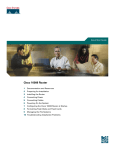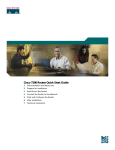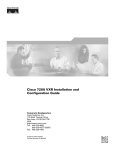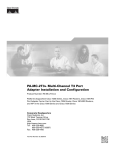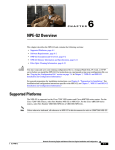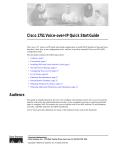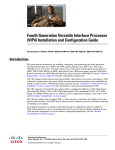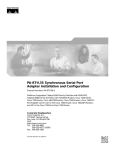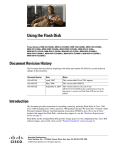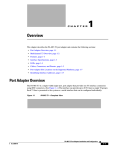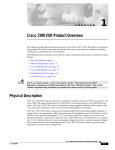Download Cisco Systems 7401 Network Router User Manual
Transcript
Quick Start Guide Cisco 7401ASR Router 1 Documentation and Resources 2 Prepare for Installation 3 Install the Parts 4 Rack-Mount the Router 5 Connect the Router to the Network 6 Connect Power to the Router 7 Configure the Router 8 Obtain Technical Assistance 1 Documentation and Resources This section contains information to help you prepare for installing the Cisco 7401ASR router. It contains a list of online documentation and resources. Documentation Survey Is Cisco documentation helpful? Click here or go to http://forums.cisco.com/eforum/servlet/viewsflash?cmd=showform&pollid=rtgdoc01!rtgdoc to give us your feedback. Related Documentation For detailed hardware installation instructions, refer to the online Cisco 7401ASR Installation and Configuration Guide—DOC-7812243 at: http://www.cisco.com/univercd/cc/td/doc/product/core/7401/7401icg/index.htm For other documentation, see the following online documents that list other documentation and provide links to the documents: • Cisco 7401 Router Documentation Master Index at: http://www.cisco.com/univercd/cc/td/doc/product/core/7401/ol3514.htm • Cisco 7401 Router Port Adapter Documentation Master Index at: http://www.cisco.com/univercd/cc/td/doc/product/core/7401/ol3533.htm • Cisco 7401 Router Troubleshooting Master Index—This document provides links to troubleshooting documentation, TAC Tech Notes, and troubleshooting tools and utilities at: http://www.cisco.com/univercd/cc/td/doc/product/core/7401/ol3517.htm Other Useful Links • For Cisco IOS Configuration documentation including release notes and feature modules, see: http://www.cisco.com/univercd/cc/td/doc/product/software/index.htm Obtain Documentation Cisco provides several ways to obtain documentation, technical assistance, and other technical resources. These sections explain how to obtain technical information from Cisco Systems. Cisco.com You can access the most current Cisco documentation on the World Wide Web at this URL: http://www.cisco.com/univercd/home/home.htm You can access the Cisco website at this URL: http://www.cisco.com International Cisco websites can be accessed from this URL: http://www.cisco.com/public/countries_languages.shtml Documentation CD-ROM Cisco documentation and additional literature are available in a Cisco Documentation CD-ROM package, which may have shipped with your product. The Documentation CD-ROM is updated regularly and may be more current than printed documentation. The CD-ROM package is available as a single unit or through an annual or quarterly subscription. Registered Cisco.com users can order a single Documentation CD-ROM (product number DOC-CONDOCCD=) through the Cisco Ordering tool: http://www.cisco.com/en/US/partner/ordering/ordering_place_order_ordering_tool_launch.html 2 All users can order monthly or quarterly subscriptions through the online Subscription Store: http://www.cisco.com/go/subscription Ordering Documentation You can find instructions for ordering documentation at this URL: http://www.cisco.com/univercd/cc/td/doc/es_inpck/pdi.htm You can order Cisco documentation in these ways: • Registered Cisco.com users (Cisco direct customers) can order Cisco product documentation from the Networking Products MarketPlace: http://www.cisco.com/en/US/partner/ordering/index.shtml • Nonregistered Cisco.com users can order documentation through a local account representative by calling Cisco Systems Corporate Headquarters (California, U.S.A.) at 408 526-7208 or, elsewhere in North America, by calling 800 553-NETS (6387). Documentation Feedback You can submit comments electronically on Cisco.com. On the Cisco Documentation home page, click Feedback at the top of the page. You can e-mail your comments to [email protected]. You can submit comments by using the response card (if present) behind the front cover of your document or by writing to the following address: Cisco Systems Attn: Customer Document Ordering 170 West Tasman Drive San Jose, CA 95134-9883 We appreciate your comments. Obtain Additional Publications and Information Information about Cisco products, technologies, and network solutions is available from various online and printed sources. • The Cisco Product Catalog describes the networking products offered by Cisco Systems, as well as ordering and customer support services. Access the Cisco Product Catalog at this URL: http://www.cisco.com/en/US/products/products_catalog_links_launch.html • Cisco Press publishes a wide range of networking publications. Cisco suggests these titles for new and experienced users: Internetworking Terms and Acronyms Dictionary, Internetworking Technology Handbook, Internetworking Troubleshooting Guide, and the Internetworking Design Guide. For current Cisco Press titles and other information, go to Cisco Press online at this URL: http://www.ciscopress.com • Packet magazine is the Cisco quarterly publication that provides the latest networking trends, technology breakthroughs, and Cisco products and solutions to help industry professionals get the most from their networking investment. Included are networking deployment and troubleshooting tips, configuration examples, customer case studies, tutorials and training, certification information, and links to numerous in-depth online resources. You can access Packet magazine at this URL: http://www.cisco.com/go/packet • iQ Magazine is the Cisco bimonthly publication that delivers the latest information about Internet business strategies for executives. You can access iQ Magazine at this URL: http://www.cisco.com/go/iqmagazine • Internet Protocol Journal is a quarterly journal published by Cisco Systems for engineering professionals involved in designing, developing, and operating public and private internets and intranets. You can access the Internet Protocol Journal at this URL: http://www.cisco.com/en/US/about/ac123/ac147/about_cisco_the_internet_protocol_journal.html • Training—Cisco offers world-class networking training. Current offerings in network training are listed at this URL: http://www.cisco.com/en/US/learning/le31/learning_recommended_training_list.html 3 2 Prepare for Installation This section contains information about tools and parts, warnings, site preparation information, and information for workbench or tabletop installation and rack-mount installation. Warning Only trained and qualified personnel should install, replace, or service this equipment. Warning Read the installation instructions before you connect the system to its power source. Warning This unit is intended for installation in restricted access areas. A restricted access area is where access can only be gained by service personnel through the use of a special tool, lock and key, or other means of security, and is controlled by the authority responsible for the location. Before beginning this router installation, read the Cisco 7401ASR Regulatory Compliance and Safety Information. Site Preparation and Unpacking • Lift the router safely out of the packing container. • Ensure the power service at the site is suitable for the router you are installing. • Check the packing slip to ensure that all the proper components are present. • Locate and have accessible the Site Log for recording information about this installation. Tools and Parts Use the following list of tools and parts as a checklist for preparing for installing the Cisco 7401ASR router: • ESD-preventative wrist strap • Power cord • Appropriate cables to connect the router to the network and console terminal • One serial port adapter cable for each serial port to connect the port with the remote device or network Ethernet transceiver • Data service unit (DSU) to connect each serial port to an external network • Tape measure and level • Screwdrivers: Number 2 Phillips screwdriver and 3/16-inch flat-blade screwdriver • Grounding lug and wires: – A grounding lug with two number-10 screw holes with a 0.63-inch (16.002-mm) spacing between them – A wire receptacle large enough to accept a 6-AWG multistrand, copper wire – Two Phillips machine screws with locking washers—M5 (metric), 0.031-inch (.08-mm) pitch, 0.315-inch (8-mm) length – A crimping tool to fit the grounding lug wire receptacle – One grounding wire—6-AWG, 0.162-inch (4.115-mm) diameter, with approximately 0.108-inch (2.743-mm) insulation, for a total wire diameter of approximately 0.27 inches (6.858 mm). The wire length depends on your router location and site environment. • The rack-mount and cable-management kit: – Two rack-mount brackets and one cable management bracket – Screws: Four 12-24 x 0.5-inch screws, four 8-18 x .37-inch screws for use with a 19-inch rack, four 8 x .375-inch screws for use in a 21–23-inch rack, and one M4 x 20-mm screw 4 • T1 channel service unit/data service unit (CSU/DSU) that converts the High-Level Data Link Control (HDLC) synchronous serial data stream into a T1 data stream with the correct framing and ones density to connect a serial port to a T1 network. (Some telephone systems require a minimum number of 1 bits per time unit in a data stream, called ones density.) Several T1 CSU/DSU devices are available as additional equipment, and most provide a V.35, EIA/TIA-449, or EIA-530 electrical interface. Prepare for Workbench or Tabletop Installation For a workbench or tabletop installation, verify the following before installing the router: • The router is off the floor and has adequate ventilation. • An adequate chassis ground (earth) connection exists for the router. • The router has at last 3 inches (7.62 cm) of clearance at the inlet and exhaust vents (sides of router). • The router has 19 inches (48.3 cm) clearance at the front and rear to allow for CompactFlash Disk, Gigabit Interface Converter (GBIC), and port adapter replacement or installation, or to access cables or equipment. • The port adapter filler panel is installed if a port adapter is not installed. The slot must not be empty. For cable-management bracket installation instructions, see page 14. Prepare for Rack-Mount Installation Make these decisions before you begin the rack-mounting tasks: • Decide whether or not you want to front- or rear-mount the chassis. • Decide whether or not you want to attach the cable-management bracket. • Determine the type of rack—four-post or two-post—that you will be using. Identify I/O Panel Ports D LE AB EN S IER LL R RM CE CAR LA RX RX RX A 4 TX RX ENHANCED 5 7 ATM 8 10 11 13 1 3 6 9 12 57606 2 1 Port adapter slot (installed port adapter shown) 8 Console port 2 Port adapter latch 9 Alarm port 3 GBIC port 0 10 Ground for ESD wrist strap with banana jack 4 FE port 0 11 Power switch 5 FE port 1 12 CompactFlash Disk slot 6 GBIC port 1 13 Power connector 7 Auxiliary port 5 3 Install the Parts This section provides installation instructions for the CompactFlash Disk, Gigabit Interface Converter, and port adapter. Install the CompactFlash Disk Figure 1 Inserting the CompactFlash Disk 2 57604 1 1 Insert the CompactFlash Disk 2 Remove the CompactFlash Disk Insert the CompactFlash Disk into the CompactFlash Disk slot (1) with the label with the vendor name and memory size facing up. The CompactFlash Disk protrudes when completely inserted. To remove the CompactFlash Disk, grasp and pull it from the slot (2). About the CompactFlash Disk Note Only the CompactFlash Disk is supported in a Cisco 7401ASR router. Other types of Flash Disks are not supported. • The larger the CompactFlash Disk size, the longer the system boot time. • The CompactFlash Disk supports online insertion and removal (OIR). • Use the CompactFlash Disk to store your configuration files and Cisco IOS software image. The Cisco 7401ASR router has no onboard Flash memory. For more information on CompactFlash Disks, see the Cisco 7401 Installation and Configuration Guide. 6 Install the Gigabit Interface Converter Warning Because invisible laser radiation may be emitted from the aperture of the port when no fiber cable is connected, avoid exposure to laser radiation and do not stare into open apertures. Warning Class 1 laser product. Warning Class 1 LED product. • Only two of the four Gigabit Ethernet or Fast Ethernet/Ethernet ports may be used at the same time. • GBIC port 0, FE port 0, and the port adapter are on PCI bus 0. GBIC port 1 and FE port 1 are on PCI bus 1. • The Gigabit Interface Converter supports online insertion and removal (OIR). • Both native Gigabit Ethernet ports and Fast Ethernet/Ethernet ports are reported as GE0/0 and GE0/1 in software. You must use the media-type command to select which media type you want to use before you configure these ports. See page 26. • For more information on Gigabit Ethernet GBICs, mode conditioning patch cords, cabling specifications, see the Cisco 7401 Installation and Configuration Guide. Figure 2 Installing a Gigabit Ethernet GBIC 3 2 4 57603 5 1 1 GBIC 4 GBIC port1 2 Alignment groove 5 Plug 3 GBIC port 0 Step 1 Turn the Gigabit Ethernet Gigabit Interface Convertor (GBIC) (1) so the label side is up and the alignment groove (2) is down. Note Step 2 The GBIC is keyed so that it cannot be inserted incorrectly. Insert the GBIC into GBIC port 0 or 1. Repeat Step 2 if you are inserting a second GBIC. Do not remove the GBIC plugs until you are ready to install the cables. 7 Replace the SDRAM DIMM The SDRAM DIMM comes installed with your Cisco 7401ASR router. To replace the SDRAM, follow these instructions: Warning Only trained and qualified personnel should be allowed to install, replace, or service this equipment. Warning Before working on a chassis or working near power supplies, unplug the power cord on AC units; disconnect the power at the circuit breaker on DC units. Warning When performing the following procedures, wear a grounding wrist strap to avoid ESD damage to the card. Some platforms have an ESD connector for attaching the wrist strap. Do not directly touch the system board with your hand or any metal tool, or you could shock yourself. Removing the Cover Step 1 Power off the router. Step 2 Remove any cables from the Cisco 7401ASR router, including the power cables. For AC power supplies, unplug the AC power cord from the power outlet. For DC power supplies, to ensure that all power is off, locate the circuit breaker on the panel board that services the DC circuit, switch the circuit breaker to the OFF position, and tape the switch handle of the circuit breaker in the OFF position. Step 3 Remove the Cisco 7401ASR router from the rack, if it is rack-mounted. Figure 3 Removing the Screws and Loosening the Cover 1 2 D LE AB S IER LL R RM CE CAR LA RX RX RX A TX RX ENHANCED ATM 66448 EN 1 Cover screws Step 4 2 Cover removal slot and screwdriver Remove the four screws holding the cover to the chassis. Note If needed, use a Phillips recess flat-head screw, M3.5 x 6-mm long, type B thread, steel with black zinc coating, as a replacement. Step 5 Insert a flat-blade screwdrivers in each of the side cover removal slots. Step 6 Push the screwdriver blade against the cover latches to release the cover, as shown in Figure 3. The cover moves forward about one-quarter inch. 8 Figure 4 Removing the Cover D LE AB S IER LL R RM CE CAR LA RX RX RX A TX RX ENHANCED ATM 66449 EN Step 7 Slide the cover forward about one-half inch and then lift it from the chassis. Remove and Install the DIMM Follow these steps to remove and install the SDRAM DIMM. Figure 5 Removing and Replacing the DIMM 3 66284 2 1 1 Latch on DIMM socket 2 DIMM 3 Notch Step 1 Attach an ESD-preventative wrist strap between you and an unpainted router surface. Step 2 Locate the DIMM. Step 3 Press both spring latches outward to release the DIMM. See Figure 5. Step 4 Gently pull the DIMM free from the DIMM socket, taking care not to touch the pins that insert into the socket. Place the DIMM in an anti-static bag. 9 Forcing the DIMM, into the socket can damage the DIMM. Use the notches on the DIMM to align the DIMM in the DIMM socket before inserting it. Caution Step 5 Locate the notches and align the DIMM with the socket before inserting it. Step 6 Gently insert the new DIMM, taking care not to damage the pins on the edge of the DIMM. Step 7 Press the spring latches to lock the DIMM in place. Step 8 Replace the cover; lower it onto the chassis and push the cover toward the rear of the chassis to lock it in place. Step 9 Replace and tighten the four cover screws. Step 10 Replace the Cisco 7401ASR router in the rack. See the “Rack-Mount the Router” section on page 12 for instructions. Step 11 Attach the cables and thread them through the cable management bracket if appropriate. Step 12 Attach the power cables. If you have a DC power supply, attach the –V and +V leads to the power supply. Repeat this step if you have a dual-DC power supply. Then switch the circuit breaker to the ON position. Step 13 Power on the router. For memory specifications and configurations, see the online Cisco 7401ASR Installation and Configuration Guide at http://www.cisco.com/univercd/cc/td/doc/product/core/7401/7401icg/index.htm. Replace the Port Adapter or Service Adapter The port adapter or service adapter ships installed. These instructions are provided for future use. Cabling information is included with the specific port adapter documentation. Figure 6 Inserting the Port Adapter 3 D R LS RIE M CEL CAR AR RX RX RX AL TX RX ENHANCED ATM 57579 LE AB EN 1 2 4 1 Port adapter latch 3 Port adapter slot guide 2 Port adapter partially removed 4 Ground for ESD wrist strap banana jack Warning 10 When performing the following procedures, wear a grounding wrist strap to avoid ESD damage to the card. Some platforms have an ESD connector for attaching the wrist strap. Do not directly touch the midplane or backplane with your hand or any metal tool, or you could shock yourself. Step 1 Use an ESD wrist strap to ground yourself to the router. A banana jack ground is to the left of the power switch. Step 2 To remove a port adapter, use a Phillips screwdriver to turn the screw holding the port adapter latch. The screw should be loose enough to allow the latch to rotate to an unlocked position (1). The latch can rotate 360o. Step 3 Grasp the handle and pull the port adapter (2) from the router, about halfway out of its slot. If you are removing a blank port adapter, pull the blank port adapter completely out of the chassis slot. Step 4 With the port adapter halfway out of the slot, disconnect all cables from the port adapter. After disconnecting the cables, pull the port adapter from its chassis slot. Caution The port adapter must slide into the slot guides (3) close to the chassis lid. Do not allow the port adapter components to come in contact with the system board or the port adapter could be damaged. Step 5 To insert the port adapter, carefully align the port adapter carrier in the slot guides (3), and slide the new port adapter halfway into the chassis. Step 6 Connect all required cables to the port adapter. After connecting all required cables, carefully slide the port adapter all the way into the slot until the port adapter is seated. Step 7 After the port adapter is properly seated, turn and secure the port adapter latch in the upright, locked position (1). Tighten the screw to ensure the port adapter remains firmly in place. Also see the appropriate port adapter documentation at: http://www.cisco.com/univercd/cc/td/doc/product/core/7401port_adp/index.htm. 11 4 Rack-Mount the Router This section provides information for rack-mounting the router. Attach the Rack-Mount Brackets—Chassis Front-Mounted Figure 7 Attaching the Rack-Mount Brackets to the Front of the Chassis D LE AB S IER LL R RM CE CAR LA RX RX RX A TX RX ENHANCED ATM 50531 EN 1 1 Rack-mount bracket 2 2 4 screws, 8-18 x .37 in., for use with a 19-inch rack 4 screws, 8 x .375 in., for use in a 21–23-inch rack Depending on how the rack-mount brackets are attached to the chassis, the chassis either protrudes from the rack or is recessed in the rack. Step 1 Locate the rack-mount and cable-management brackets and screws and a Number 2 Phillips screwdriver. Step 2 Align the rack-mount bracket (1) to the side of the router. Depending on which set of rack-mount bracket holes you choose to use to attach the rack-mount bracket to the router, the chassis will either be recessed in the rack, or protrude from the rack. Step 3 Insert and tighten the two screws (2). Repeat Steps 1 and 2 on the other side of the router. Step 4 To install the cable-management bracket, see page 11. If you are not installing the cable-management bracket, skip to the “Four-Post Rack Installation” section on page 15 or the “Two-Post Rack Installation” section on page 16 for rack-mount instructions. 12 Attach the Rack-Mount Brackets—Chassis Rear-Mounted Figure 8 Attaching the Rack-Mount Brackets to the Rear of the Chassis 2 D S IER LL R RM CE CAR LA RX RX RX A TX RX ENHANCED ATM 1 1 Rack-mount bracket 2 50532 LE AB EN 4 screws, 8-18 x .37 in., for use with a 19-inch rack 4 screws, 8 x .375 in., for use in a 21–23-inch rack Depending on how the rack-mount brackets are attached to the chassis, it either protrudes from the rack or is recessed in the rack. Step 1 Locate the rack-mount brackets and screws and a Number 2 Phillips screwdriver. Step 2 Align the rack-mount bracket (1) to the side of the router and insert and tighten the screws (2). Depending on which set of holes on the rack-mount bracket that you use, the router will either be recessed in the rack or protrude from the rack. Note To use the cable-management bracket with the Cisco 7401ASR router rear-mounted, you must purchase a second rack-mount kit, attach a rack-mount bracket to the left front of the chassis, and attach the cable-management bracket to it. See page 14 for cable-management bracket installation instructions. Go to the “Four-Post Rack Installation” section on page 15 or the “Two-Post Rack Installation” section on page 16. 13 Attach the Cable-Management Bracket Figure 9 Attaching the Cable-Management Bracket 1 D LE AB S IER LL R RM CE CAR LA RX RX RX A TX RX 57578 EN 2 1 Cable-management bracket 2 M4 x 20-mm screw Step 1 Align the cable-management bracket (1) to the rack-mount bracket on the left side of the Cisco 7401ASR router. Step 2 Using a Phillips screwdriver and the M4 x 20-mm screw (2), thread and tighten the screw to the cable-management bracket. Go to the “Four-Post Rack Installation” section on page 15 or the “Two-Post Rack Installation” section on page 16. 14 Four-Post Rack Installation Figure 10 Installing the Cisco 7401ASR Router in a Four-Post Rack 1 D LE AB EN S IER LL R RM CE CAR LA RX RX RX A TX RX ENHANCED ATM 2 50534 3 1 Four-post rack 2 Screw hole for cable-management bracket Note 3 Four 12-24 x 0.5-inch screws Inner clearance (the width between the inner sides of the two posts or rails) must be at least 17.3 inches (43.9 cm) The height of the chassis is 1.72 inches (4.37 cm). Airflow through the chassis is from front to back. Step 1 Make sure that the port adapter latch is in the locked position and the screw is tightened. Step 2 Make sure the rack brakes are locked or the rack is stabilized. Step 3 Position the router so the front is closest to you and lift it carefully into the rack. To prevent injury, avoid any sudden twists or moves. Step 4 Slide the chassis into the rack, pushing it back until the brackets meet the mounting strips or posts on both sides of the rack. Step 5 Keeping the brackets flush against the posts or mounting strips, align the holes in the brackets with the holes on the rack or mounting strip. Step 6 For each bracket, insert and tighten two 12-24 x 0.5-inch screws (3) to the rack. 15 Two-Post Rack Installation Figure 11 Installing the Cisco 7401ASR Router in a Two-Post or Telco Rack 1 D R LS RIE M CEL CAR AR RX RX RX AL TX RX ENHANCED ATM 2 1 Two-post or telco-type rack 2 Screw hole for cable-management bracket 57572 LE AB EN 3 3 Four 12-24 x 0.5-inch screws Note Inner clearance (the width between the inner sides of the two posts or rails), must be at least 17.3 inches (43.9 cm) The height of the chassis is 1.72 inches (4.37 cm). Airflow through the chassis is from front to back. Step 1 Make sure that the port adapter latch is in the locked position and the screw is tightened. Step 2 Make sure the rack brakes are locked or the rack (1) is stabilized. Step 3 Position the router so the front is closest to you and lift it carefully into the rack. To prevent injury, avoid any sudden twists or moves. Step 4 Slide the chassis into the rack, pushing it back until the brackets meet the mounting strips or posts on both sides of the rack. Step 5 Keeping the brackets flush against the posts or mounting strips, align the holes in the brackets (3) with the holes on the rack or mounting strip. Step 6 For each bracket, insert and tighten two 12-24 x 0.5-inch screws (3) to the rack. 16 Chassis Ground Connection Installation Figure 12 Attaching the Grounding Lug and Wire to the Chassis 3 2 50536 4 1 1 Chassis ground connector 3 Screws 2 Grounding lug 4 Wire Note The grounding lug and Phillips screws are not available from Cisco Systems. Get the grounding lug from an electrical-connector vendor and the screws from a hardware vendor. See Page 4 for the parts needed. Step 1 Locate the chassis ground connector (1) on the rear of your router chassis. Step 2 Use the wire stripper to strip one end of the 6-AWG wire approximately 0.75 inches (19.05 mm). Step 3 Insert the 6-AWG wire (4) into the wire receptacle on the grounding lug. Step 4 Use the crimping tool to carefully crimp the wire receptacle around the wire; this step is required to ensure a proper mechanical connection. Step 5 Insert the two screws (3) through the holes in the grounding lug (2). Step 6 Use the Number 2 Phillips screwdriver to carefully tighten the screws until the grounding lug is held firmly to the chassis. Do not overtighten the screws. Step 7 Connect the opposite end of the grounding wire to the appropriate grounding point at your site to ensure an adequate chassis ground. 17 5 Connect the Router to the Network This section provides information about cables and ports and attaching the router to the network. Attaching the Console and Auxiliary Port Cables 1 3 4 2 57577 Figure 13 5 1 Auxiliary port 4 Cable to modem or DCE 2 Console port 5 Cable to console terminal or DTE 3 RJ-45 connector Console and Auxiliary Port Cable Connections Note Both the console and auxiliary ports are asynchronous serial ports; any devices connected to these ports must be capable of asynchronous transmission. The DCE-mode console port is for connecting a console terminal and the DTE-mode auxiliary port is for connecting a modem or other DCE device (such as a CSU/DSU or other router) to your router. Step 1 Before connecting a terminal to the console port, configure the terminal to match the router console port as follows: 9600 baud, 8 data bits, no parity, 2 stop bits (9600 8N2). Step 2 Use an auxiliary and console port cable. (An auxiliary port and console port cable and adapter kit is available from Cisco Systems—Product Number ACS-2500ASYN=.) Use the console cable to connect the terminal to the console port. After you establish normal router operation, you can disconnect the terminal. Note You must supply your own interface cable between the auxiliary port and the equipment you are connecting. For console and auxiliary port pinouts, see the online Cisco 7401ASR Installation and Configuration Guide. Gigabit Ethernet and Fast Ethernet Port Connections The Cisco 7401ASR router has two native 10/100/1000-Mbps Ethernet interfaces. Each interface consists of two physical ports, an RJ-45 media port and a GBIC media port. The RJ-45 media ports provides 10/100-Mbps connectivity while the GBIC media ports provides 1000-Mbps connectivity. Note The RJ-45 media is not capable of 1000 Mbps. This is only available via the Gigabit Ethernet GBIC media. Note Any two of the four Ethernet ports may be used at the same time. 18 For more information, see the online Cisco 7401ASR Installation and Configuration Guide. Figure 14 2 3 4 57832 1 Gigabit Ethernet and Fast Ethernet/Ethernet Port Identification 1 Gigabit Ethernet (GBIC) port 0 3 Fast Ethernet/Ethernet (100 Mbps) port 1 2 Fast Ethernet/Ethernet (100 Mbps) port 0 4 Gigabit Ethernet (GBIC) port 1 Fast Ethernet RJ-45 Connections Figure 15 Attaching the Fast Ethernet Cables 1 2 1 Fast Ethernet/Ethernet port 0—RJ-45 connector 2 Fast Ethernet/Ethernet port 1—RJ-45 connector 57696 3 3 Fast Ethernet/Ethernet cables Intra-Building Lightning Protection Shielded cables which are grounded at both ends are required to be used on the 10/100 Ethernet port in order to be in compliance with requirement R4-11 in GR-1089-Core for a Central Office environment. This is not a requirement for customer premise installations. Warning To avoid electric shock, do not connect safety extra-low voltage (SELV) circuits to telephone-network voltage (TNV) circuits. LAN ports contain SELV circuits, and WAN ports contain TNV circuits. Some LAN and WAN ports both use RJ-45 connectors. Use caution when connecting cables. To identify the RJ-45 cable type, hold the two ends of the cable next to each other so you can see the colored wires inside the ends. The straight-through wire type has colored wires in the same sequence at both ends. In the crossover wire type, the first colored wire at the far left is the third colored wire at the other end. The second colored wire at the far left is the sixth colored wire at the other end. Attach RJ-45 Ethernet cables to the appropriate connector. 19 Both native Fast Ethernet/Ethernet ports and Gigabit Ethernet ports are reported as GE0/0 and GE0/1 in software. You must use the media-type command to select which media type you want to use before you configure these ports. See “Configure the Native Gigabit Ethernet and Fast Ethernet/Ethernet Interfaces” section on page 28. Note GBIC Cabling and Connection Equipment The Gigabit Interface Converter (GBIC) port is a 1000-Mbps optical interface in the form of an SC-type duplex port that supports IEEE 802.3z interfaces compliant with the 1000BASEX standard. Gigabit Interface Converter models WS-G5486 or GBIC-SX=, WS-G5484 or GBIC-LX/LH=, and WS-G5487 or GBIC-ZX-SM= are supported in the Cisco 7401ASR router. For cabling distances, specifications, and other information, see the online Cisco 7401ASR Router Installation and Configuration Guide at http://www.cisco.com/univercd/cc/td/doc/product/core/7401/7401icg/index.htm. All Gigabit Ethernet GBIC ports have SC-type connectors. Note Because invisible laser radiation may be emitted from the aperture of the port when no fiber cable is connected, avoid Warning exposure to laser radiation and do not stare into open apertures. Warning Class 1 laser product. Warning Class 1 LED product. Figure 16 Inserting the Gigabit Ethernet Cables into the GBIC 1 5 6 7 3 57580 2 4 1 To external 1000BASEX network 5 RX (GBIC port 0) 2 1 duplex connector (TX and RX) 6 TX (GBIC port 0) 3 To external 1000BASEX network 7 GBIC port 1 4 2 simplex connectors Note There is no support for copper-based GBICs (1000BASET) as these do not conform to the GBIC standard and have not been validated by Cisco. Step 1 Remove the GBIC plug. 20 Attach the appropriate optical fiber cable directly to the SC-type port on the GBIC. You can use either simplex or duplex connectors for most devices. Step 2 Two cables are required for simplex connectors, one cable for transmit (TX) and one for receive (RX). One cable that has both TX and RX connectors is required for duplex connectors. If you plan to use a GBIC-LX/LH at distances greater than 984.25 feet (300 meters) over 50/125-micron or 62.5/125-micron multimode fiber, to prevent data transmission problems you must use the mode-conditioning patch cord. Caution Attach a Mode-Conditioning Patch Cord Figure 17 Attaching the Mode-Conditioning Patch Cord 6 2 RX 3 1 // // Offset // 7 8 6 9 TX 4 5 1 1 Beige color identifier 6 Multimode bar 2 To GE interface 7 Single-mode bar 3 RX 8 Offset 4 TX 9 To cable plant 5 Blue color identifier 57011 1 Step 1 Attach the patch cord to the SC-type receptacle on the GBIC (2). Step 2 Attach the network ends of your patch cord to the appropriate 1000BASEX equipment in your building cable plant (9). Note Ensure that you connect the TX and RX ports on one end of the patch cord to the RX and TX ports (respectively) on the other end. Connect TX to RX and RX to TX. A mode-conditioning patch cord can be used with the GBIC-LX/LH to allow reliable laser transmission between the single-mode laser source on the GBIC and a multimode optical fiber cable. 21 Port Adapter Cable Connections The instructions for connecting the cables for each port adapter installed in the Cisco 7401ASR router are in the respective online note for each port adapter. The documents are available on the Documentation CD-ROM and on Cisco.com at http://www.cisco.com/univercd/cc/td/doc/product/core/7200vx/portadpt/index.htm. Also see the release notes for any information about a specific port adapter. Release notes are found at http://www.cisco.com/univercd/cc/td/doc/product/software/index.htm. Alarm Port Connection Figure 18 Connecting the Alarm Port Cable 57725 1 1 Alarm port Connect the dry relay alarm port cable connector to the alarm port. It cannot be inserted incorrectly. The dry relay alarm port operates at 50V AC/DC maximum and up to 80 mA maximum. Total power dissipation should not exceed 300 milliwatts. The normally closed position will have from 15 to 30 ohms resistance. The open position will be greater than 1 megohom. The alarm condition is the closed position. This port is a switch so that the cable connector can be inserted in either orientation. Cable Management Figure 19 Inserting the Cables Through the Cable-Management Bracket 2 D LE AB S IER LL R RM CE CAR LA RX RX RX A TX RX ENHANCED ATM 57581 EN 1 1 Input/output cables 2 Cable-management bracket If you have not already done so, run the port adapter and input/output cables through the cable-management bracket. 22 6 Connect Power to the Router This section provides instructions for attaching the power cables to the router and powering on the router. Warning This unit might have more than one power cord. To reduce the risk of electric shock, disconnect the two power supply cords before servicing the unit. Warning The AC power supply has double pole/neutral fusing. The Cisco 7401ASR router comes with either an AC or DC power supply. A dual DC power supply option is available. Connect AC-Input Power Figure 20 Attaching the AC Power Cable 57576 2 1 1 AC power connector 2 Power switch Step 1 Check that the power switch (2) is in the off (O) position. Step 2 Plug the power cable into the AC connector (1) on the router. Step 3 Plug the AC power supply cable into the AC power source. Connect DC-Input Power Note Warning Step 1 The color coding of the DC-input power supply leads depends on the color coding of the DC power source at your site. Make certain the lead color coding you choose for the DC-input power supply matches lead color coding used at the DC power source. Before completing any of the following steps, and to prevent short-circuit or shock hazards, ensure that power is removed from the DC circuit. To ensure that all power is OFF, locate the circuit breaker on the panel board that services the DC circuit, switch the circuit breaker to the OFF position, and tape the switch handle of the circuit breaker in the OFF position. At the rear of the router, check that the power switch is in the off (O) position. 23 Step 2 Ensure that no current is flowing through the DC power supply leads. To ensure that all power is OFF, locate the circuit breaker on the panel board that services the DC circuit, switch the circuit breaker to the OFF position, and tape the switch handle of the circuit breaker in the OFF position. Step 3 Using a wire stripper, strip approximately 0.55 inch (14 mm) from the –V and +V leads. 4 50538 A A B Attaching the Wires to the DC Plug and the DC Plug to the DC Connector B Figure 21 3 1 5 2 1 DC plug 4 Single DC power supply connector 2 Lead 5 Dual DC power supply connectors 3 + and – embossed on connector Step 4 To determine which lead to connect to which screw in the DC plug, align the DC plug (1) with the DC connector (4, 5) in the chassis as shown in the illustration above. Do not insert the plug in the connector. Notice the symbols, + A – , embossed on the connector (3). Use the symbols and the orientation of the plug to guide you when inserting the leads into the plug. Step 5 Loosen the screws in the DC plug (1), insert the +V and –V leads, and tighten the screws. Step 6 Insert the DC plug (1) into the DC connector (4) in the chassis. Step 7 Repeat Step 5 and Step 6 if you have a dual DC power supply (5). Step 8 Switch the circuit breaker to the ON position Observe System Startup and Performing a Basic Configuration Check conditions prior to system startup: Step 1 Check that all hardware parts and cables are securely attached to the chassis. Step 2 Check that port adapter configuration information is available, if needed. Step 3 Check that a CompactFlash Disk is installed. Step 4 Check that the console terminal is turned on. 24 Start the Router Step 1 Place the power switch in the on (|) position. Step 2 Listen for the fans; they should be operating as soon as power is turned on. Note After powering off the router, wait at least 30 seconds before powering it on again. The following table provides information about the LEDs as the system starts. Figure 22 Identifying LEDs and LED Status 2 5 3 6 4 7 57605 1 9 10 8 No. LED Label LED Color In the Power Up state, the LED is LED flashes when there is traffic 1 GBIC 0 ENABLE GBIC ENABLE (0) Green ON No, remains constantly on 2 LINK GBIC LINK (0) Green — Yes 3 FE 0 LINK FE LINK (0) Green — Yes 4 100 Mbps FE (0) Green ON No, remains constantly on 5 GBIC 1 ENABLE GBIC ENABLE (1) Green — No, remains constantly on 6 LINK GBIC LINK (1) Green ON Yes 7 FE 1 LINK FE LINK (1) Green — Yes 8 100 Mbps FE (1) Green ON No, remains constantly on 9 STATUS System Status Green ON No, remains constantly on 10 COMPACT FLASH CompactFlash Disk Green ON, if the CompactFlash Disk is inserted and functioning No, remains constantly on Step 3 During the boot process, observe the system LEDs. The STATUS LED comes on immediately as amber, then turns to green when the IOS is booted. Port adapter LEDs go on and off irregularly. Step 4 Observe the initialization process. The LEDs on the port adapter behave differently (most flash on and off). The ENABLED LED on each port adapter goes on when initialization is completed and the console screen displays a script and system banner. 25 7 Configure the Router Perform a Basic Configuration Using the Setup Facility If you do not plan to use AutoInstall, do not connect the router’s serial (WAN) cable to the channel service unit/data service unit (CSU/DSU). If the WAN cable is not connected, the router boots from Flash memory and goes automatically into the setup facility. You can run the setup facility any time you are at the enable prompt (#) by entering the setup command. If the serial (WAN) cable is connected to the CSU/DSU and the router does not have a configuration stored in NVRAM, the router attempts to run AutoInstall at startup. The router may take several minutes to determine that AutoInstall is not set up to a remote TCP/IP host. Once the router determines that AutoInstall is not configured, it defaults to the setup facility. Configure Global Parameters When you first start the setup program, you must configure the global parameters. These parameters are used for controlling system-wide settings. Complete the following steps to enter the global parameters: Step 1 Connect a console terminal to the console port, and then boot the router. The system boots from Flash memory. The following information appears after about 30 seconds. When you see this information, you have successfully booted your router: Restricted Rights Legend Use, duplication, or disclosure by the Government is subject to restrictions as set forth in subparagraph (c) of the Commercial Computer Software - Restricted Rights clause at FAR sec. 52.227-19 and subparagraph (c) (1) (ii) of the Rights in Technical Data and Computer Software clause at DFARS sec. 252.227-7013. cisco Systems, Inc. 170 West Tasman Drive San Jose, California 95134-1706 Cisco Internetwork Operating System Software IOS (tm) 7400 Software (C7400-JS-M) Version 12.2 Copyright (c) 1986-2001 by cisco Systems, Inc. Compiled Fri 19-May-01 13:12 by Biff Image text-base:0x60008960, data-base:0x617CA000 cisco 7401ASR (NSE) processor (revision A) with 245760K/16384K bytes of memory. Processor board ID 4294967295 R7000 CPU at 375Mhz, Implementation 39, Rev 3.3, 256KB L2, 2000KB L3 Cache 1 slot ASR midplane, Version 2.0 Last reset from power-on Bridging software. X.25 software, Version 3.0.0. SuperLAT software (copyright 1990 by Meridian Technology Corp). TN3270 Emulation software. PXF processor tmc has been reset. 8 Ethernet/IEEE 802.3 interface(s) 2 Gigabit Ethernet/IEEE 802.3 interface(s) 509K bytes of non-volatile configuration memory. 64256K bytes of ATA PCMCIA card at slot 0 (Sector size 512 bytes). 8192K bytes of Flash internal SIMM (Sector size 256K). Press RETURN to get started! 26 Note The first two sections of the configuration script (the banner and the installed hardware) appear only at initial system startup. On subsequent uses of the setup command facility, the script begins with a System Configuration Dialog as shown in the following example. --- System Configuration Dialog --At any point you may enter a question mark '?' for help. Use ctrl-c to abort configuration dialog at any prompt. Default settings are in square brackets '[]'. Step 2 When asked if you want to enter the initial configuration dialog and see the current interface summary, enter yes or press Return: Would you like to enter the initial configuration dialog? [yes]: First, would you like to see the current interface summary? [yes]: In the following example, the summary shows a Cisco 7401ASR router at first-time startup; that is, nothing is configured. Any interface listed with OK? value "NO" does not have a valid configuration Interface ATM1/0 FastEthernet1/0 Step 3 IP-Address unassigned unassigned OK? NO NO Method unset unset Status down down Protocol down down Choose which protocols to support on your interfaces. For Internet Protocol (IP)-only installations, you can accept the default values for most of the questions. A typical configuration using IP, IPX, and AppleTalk follows and continues through Step 5: Configuring global parameters: Enter host name [Router]: Step 4 Enter enable secret, enable, and virtual terminal passwords: The enable secret password is a one-way cryptographic secret password used instead of the enable password when it exists. Enter enable secret: barney The enable password is used when there is no enable secret password and when using older software and some boot images. Enter enable password: betty Enter virtual terminal password: fred Step 5 The Simple Network Management Protocol (SNMP) is the most widely supported open standard for network management. It provides a means to access and set configuration and run-time parameters of routers and communication servers. SNMP defines a set of functions that can be used to monitor and control network elements. Enter yes or press Return to accept SNMP management; enter no to refuse it: Configure SNMP Network Management? [yes]: Community string [public]: Step 6 For the following queries, do not enable VINES, LAT, DECnet, CLNS, bridging, XNS, or Apollo: Configure Configure Configure Configure Configure Configure Configure Vines? [no]: LAT? [no]: DECnet? [no]: CLNS? [no]: bridging? [no]: XNS? [no]: Apollo? [no]: 27 Step 7 For the following queries, enable routing on AppleTalk and IPX: Configure AppleTalk? [no]: yes Multizone networks? [no]: yes Configure IPX? [no]: yes Step 8 In most cases you use IP routing. If you are using IP routing, you must also select an interior routing protocol. You can specify only one of two interior routing protocols to operate on your system using the setup facility: Interior Gateway Routing Protocol (IGRP) or Routing Information Protocol (RIP). To configure IP routing, enter yes (the default) or press Return, and then select an interior routing protocol: Configure IP? [yes]: Configure IGRP routing? [yes]: Your IGRP autonomous system number [1]: 15 The following sample display includes a continuous listing of all configuration parameters selected in Step 3 through Step 8. Only IP, IPX, and AppleTalk are the selected protocols for this example. Configuring global parameters: Enter host name [Router]: router The enable secret is a one-way cryptographic secret password used instead of the enable password when it exists. Enter enable secret: barney The enable password is used when there is no enable secret password and when using older software and some boot images. Enter enable password: betty Enter virtual terminal password: fred Configure SNMP Network Management? [yes]: Community string [public]: Configure Vines? [no]: Configure LAT? [no]: Configure AppleTalk? [no]: yes Multizone networks? [no]: yes Configure DECnet? [no]: Configure IP? [yes]: Configure IGRP routing? [yes]: Your IGRP autonomous system number [1]: 15 Configure RIP routing? [no]: Configure CLNS? [no]: n Configure bridging? [no]: Configure IPX? [no]: yes Configure XNS? [no]: Configure Apollo? [no]: Step 9 Save your settings to NVRAM. See the “Save the Running Configuration to NVRAM” section on page 33. If you do not save the configuration settings that you created in the router using configuration mode and the setup facility, your configuration will be lost the next time you reload the router. Configure the Native Gigabit Ethernet and Fast Ethernet/Ethernet Interfaces Changing the Media Type Note 28 The Cisco 7401ASR router reports both the Fast Ethernet/Ethernet and the Gigabit Ethernet ports as GE 0/0 and GE 0/1. Before configuring either port type, you must first use the media-type interface command to select the media type, either Gigibit Ethernet (gbic) or Fast Ethernet/Ethernet (rj45). Step 1 To be able to use a particular media port, use Cisco IOS to select the media type. This is done by using the media-type interface command: media-type { gbic | rj45 } Example: interface GigabitEthernet 0/0 media-type rj45 end Step 2 After changing the media type, configure the speed and duplex to appropriately match the new interface characteristics. Changing the speed and duplex of a Cisco 7401ASR router Gigabit Ethernet interface is done using the speed and duplex interface commands. Note These commands are only applicable when using the RJ-45 media. speed { 10 | 100 | 1000 | auto } duplex { full | half | auto } The following speed/duplex settings are supported: Media Type Speed Duplex ------------------------------------------------------RJ45 10, 100, auto full, half, auto GBIC ignored (1000) ignored (full) ------------------------------------------------------- (By default on this interface) When using the GBIC media, there is also the additional negotiation auto command that is used to enable the IEEE 801.1z Gigabit Ethernet (1000 Mbps) autonegotiation protocol. Step 3 To turn the negotiation auto feature off (it is on by default), issue the interface command no negotiation auto. This is useful for connecting to other Gigabit Ethernet equipment that does not support 802.1z autonegotiation. Note The negotiation auto feature is not supported when using the media type rj-45 and will be ignored if implementation is attempted. If you change from the GBIC to the rj-45 media type, you must set speed and duplex after you have executed the media-type command to ensure the interface will operate in the correct mode. The media-type GBIC mode will always default to 1000-Mbps, full-duplex operation as this is the only configuration that is supported in this mode. Any speed or duplex commands are ignored while using this media type, even if present in the config (for example, show running-config). Debug Cisco IOS provides two commands to provide information on your interfaces: show interface GigabitEthernet 0/X (where X is either 0 or 1) and show controllers GigabitEthernet 0/X (where X is either 0 or 1). The output of the show interface command is useful for determining the current operating mode of the interface (speed/duplex/media-type) and the current interface statistics. The output of the show controller command displays more information specific to the Cisco 7401ASR router Gigabit Ethernet interface. For example, it shows the detected link status, speed, and duplex, and also determines the current status of autonegotiation and the link partners’ abilities (if it is an autonegotiation-capable interface). The show controller command also displays the current operating state of the driver and the Ethernet controller hardware. The show controller command is a very powerful debugging aid, especially for Cisco engineers should you need help in debugging a problem. If you have any problems with your Gigabit Ethernet interfaces, you will need to provide this information to Cisco for analysis. 29 Reset the Interface Should you have a problem with your interface and wish to try and reset it, use the command: clear interface GigabitEthernet 0/X (where X is either 0 or 1) Clear Counters Interface counters may be cleared (reset) by using the command: clear counters GigabitEthernet 0/X (where X is either 0 or 1) This will not reset the interface. Configure Port Adapter Interfaces Following are the steps for configuring interfaces to allow communication over a LAN or WAN. To configure the interface parameters, you need your interface network addresses and subnet mask information. Consult with your network administrator for this information. Configure ATM Interfaces In the following example, an ATM interface in slot 1 is configured for an ATM LAN using IP. Follow these steps to configure an ATM interface: Step 1 Using your own addresses and mask at the setup prompts, respond to the prompts as follows: Configuring interface parameters: Configuring interface ATM1/0: Is this interface in use? [yes]: Configure IP on this interface? [yes]: IP address for this interface: 1.1.1.10 Number of bits in subnet field [0]: Class C network is 1.1.1.0, 0 subnet bits; mask is /24 Step 2 Determine if you are going to enable IPX on this interface; if you are, enter the unique IPX network number: Configure IPX on this interface? [no]: yes IPX network number [2]: Step 3 If you are using AppleTalk on the interface, enter yes. Enter yes to configure for extended AppleTalk networks, and then enter the cable range number. Enter the zone name and any other additional zones that are associated with your local zone: Configure AppleTalk on this interface? [no]: yes Extended AppleTalk network? [no]: yes AppleTalk starting cable range [0]: Step 4 Save your settings to NVRAM. See the “Save the Running Configuration to NVRAM” section on page 33. If you do not save the configuration settings that you created in the router using configuration mode and the setup facility, your configuration will be lost the next time you reload the router. Note If additional ATM interfaces are available in your system, you are prompted for their configurations as well. 30 Configure Fast Ethernet Interfaces In the following example, a Fast Ethernet interface in slot X is configured for a Fast Ethernet LAN using IP. Follow these steps to configure Fast Ethernet interfaces: Step 1 Using your own addresses and mask at the setup prompts, respond to the prompts as follows: Configuring interface parameters: Configuring interface FastEthernet1/0: Is this interface in use? [yes]: Use the 100 Base-TX (RJ-45) connector? [yes]: Operate in full-duplex mode? [no]: Configure IP on this interface? [yes]: IP address for this interface: 1.1.1.20 Number of bits in subnet field [0]: Class C network is 1.1.1.0, 0 subnet bits; mask is /24 Step 2 Determine if you are going to enable IPX on this interface; if you are, enter the unique IPX network number: Configure IPX on this interface? [no]: yes PX network number [2]: Step 3 If you are using AppleTalk on the interface, enter yes. Enter yes to configure for extended AppleTalk networks, and then enter the cable range number. Enter the zone name and any other additional zones that are associated with your local zone: Configure AppleTalk on this interface? [no]: yes Extended AppleTalk network? [no]: yes AppleTalk starting cable range [0]: Step 4 Save your settings to NVRAM. See the “Save the Running Configuration to NVRAM” section on page 33. If you do not save the configuration settings that you created in the router using configuration mode and the setup facility, your configuration will be lost the next time you reload the router. Note If additional Ethernet interfaces are available in your system, you are prompted for their configurations as well. Configure Synchronous Serial Interfaces Synchronous serial interfaces are configured to allow connection to WANs through a CSU/DSU. In the following example, a synchronous serial interface in slot X is configured for a WAN connection using IP. Follow these steps to configure synchronous serial interfaces: Step 1 Using your own addresses and mask at the setup prompts, respond to the prompts as follows: Configuring interface parameters: Configuring interface serial 1/0: Is this interface in use? [yes]: Configure IP on this interface? [yes]: IP address for this interface: 1.1.1.30 Number of bits in subnet field [0]: Class A network is 1.1.1.0, 0 subnet bits; mask is /24 Step 2 Determine if you are going to enable IPX on this interface; if you are, enter the unique IPX network number: Configure IPX on this interface? [no]: yes IPX network number [2]: 31 Step 3 If you are using AppleTalk on the interface, enter yes. Enter yes to configure for extended AppleTalk networks, and then enter the cable range number. Enter the zone name and any other additional zones that are associated with your local zone: Configure AppleTalk on this interface? [no]: yes Extended AppleTalk network? [no]: yes AppleTalk starting cable range [0]: Step 4 Save your settings to NVRAM. See the “Save the Running Configuration to NVRAM” section on page 33. If you do not save the configuration settings that you created in the router using configuration mode and the setup facility, your configuration will be lost the next time you reload the router. Note If additional synchronous serial interfaces are available in your system, you are prompted for their configurations as well. The following sample display includes a continuous listing of all interface configuration parameters selected for ATM, Fast Ethernet, and synchronous serial interfaces. Configuring interface parameters: Configuring interface ATM1/0: Is this interface in use? [yes]: Configure IP on this interface? [yes]: IP address for this interface: 1.1.1.10 Number of bits in subnet field [0]: 0 Class C network is 1.1.1.0, 0 subnet bits; mask is /24 Configure IPX on this interface? [yes]: IPX network number [2]: Configure AppleTalk on this interface? [no]: yes Extended AppleTalk network? [no]: yes AppleTalk starting cable range [0]: Configuring interface FastEthernet1/0: Is this interface in use? [yes]: Use the 100 Base-TX (RJ-45) connector? [yes]: Operate in full-duplex mode? [no]: Configure IP on this interface? [yes]: IP address for this interface: 1.1.1.20 Number of bits in subnet field [0]: Class C network is 1.1.1.0, 0 subnet bits; mask is /24 Configure IPX on this interface? [yes]: IPX network number [2]: Configure AppleTalk on this interface? [no]: yes Extended AppleTalk network? [no]: yes AppleTalk starting cable range [0]: Configuring interface Serial1/0: Is this interface in use? [no]: yes Configure IP on this interface? [no]: yes Configure IP unnumbered on this interface? [no]: IP address for this interface: 1.1.1.30 Number of bits in subnet field [0]: Class A network is 1.0.0.0, 0 subnet bits; mask is 255.0.0.0 Configure IPX on this interface? [no]: yes IPX network number [2]: Configure AppleTalk on this interface? [no]: yes Extended AppleTalk network? [no]: AppleTalk network number [1]: 32 The following configuration command script was created: hostname Router enable secret 5 $1$u8z3$PMYY8em./8sszhzk78p/Y0 enable password betty line vty 0 4 password fred snmp-server community public ! ip routing no vines routing ipx routing appletalk routing no apollo routing no decnet routing no xns routing no clns routing no bridge 1 ! Turn off IPX to prevent network conflicts. interface ATM1/0 ip address 1.1.1.10 255.0.0.1 appletalk cable-range 0-0 0.0 appletalk discovery ! interface FastEthernet1/0 media-type 100BaseX half-duplex ip address 1.1.1.20 255.0.0.2 appletalk cable-range 0-0 0.0 appletalk discovery ! interface serial3/0 ip address 1.1.1.30 255.0.0.3 ip route-cache cbus no keepalive ! router igrp 15 network 1.0.0.0 ! ! end Use this configuration? [yes/no]: yes Building configuration... Use the enabled mode ‘configure’ command to modify this configuration. Press RETURN to get started! Your router is now minimally configured and ready to use. You can use the setup command if you want to modify the parameters after the initial configuration. To perform more complex configurations, use the configure command. For information on additional interface configuration and specific system configurations, refer to the modular configuration and modular command reference publications in the Cisco IOS software configuration documentation set that corresponds to the software release installed on your Cisco hardware. Save the Running Configuration to NVRAM To store the configuration or changes to your startup configuration in NVRAM, enter the copy running-config startup-config command at the Router# prompt: Router# copy running-config startup-config Using this command saves the configuration settings that you created in the router using configuration mode and the setup facility. If you fail to do this, your configuration will be lost the next time you reload the router. 33 Check the Running Configuration Settings To check the value of the settings you have entered, enter the show running-config command at the Router# prompt: Router# show running-config To review changes you make to the configuration, use the EXEC mode show startup-config command to display the information stored in NVRAM. View Your System Configuration You can use the show version (or show hardware) and the show diag commands to display the system hardware, the software version, the names and sources of configuration files, and the boot images. Use the show diag command to determine what type of port adapter is installed. For specific information on the show version, show diag, and other commands, refer to the modular configuration and modular command reference publications in the Cisco IOS software configuration documentation set that corresponds to the software release installed on your Cisco hardware. Perform Complex Configurations After you have installed your Cisco 7401ASR router hardware and minimally configured the system, you might need to perform more complex configurations, which are beyond the scope of this publication. For specific information on system and interface configuration, refer to the modular configuration and modular command reference publications in the Cisco IOS software configuration documentation set that corresponds to the software release installed on your Cisco hardware. These publications contain additional information on using the configure command. Replace or Recover a Lost Password See the Cisco 7401ASR Installation and Configuration Guide, Chapter 3, “Starting and Configuring” for instructions. It is possible to recover the enable or console login password. The enable secret password is encrypted and must be replaced with a new enable secret password. Troubleshooting Information For system start-up troubleshooting information, see the online Cisco 7401ASR Installation and Configuration Guide at http://www.cisco.com/univercd/cc/td/doc/product/core/7401/7401icg/index.htm. 34 8 Obtain Technical Assistance Cisco provides Cisco.com, which includes the Cisco Technical Assistance Center (TAC) website, as a starting point for all technical assistance. Customers and partners can obtain online documentation, troubleshooting tips, and sample configurations from the Cisco TAC website. Cisco.com registered users have complete access to the technical support resources on the Cisco TAC website, including TAC tools and utilities. Cisco.com Cisco.com offers a suite of interactive, networked services that let you access Cisco information, networking solutions, services, programs, and resources at any time, from anywhere in the world. Cisco.com provides a broad range of features and services to help you with these tasks: • Streamline business processes and improve productivity • Resolve technical issues with online support • Download and test software packages • Order Cisco learning materials and merchandise • Register for online skill assessment, training, and certification programs To obtain customized information and service, you can self-register on Cisco.com at this URL: http://tools.cisco.com/RPF/register/register.do Technical Assistance Center The Cisco TAC is available to all customers who need technical assistance with a Cisco product, technology, or solution. Two types of support are available: the Cisco TAC website and the Cisco TAC Escalation Center. The type of support that you choose depends on the priority of the problem and the conditions stated in service contracts, when applicable. We categorize Cisco TAC inquiries according to urgency: • Priority level 4 (P4)—You need information or assistance concerning Cisco product capabilities, product installation, or basic product configuration. There is little or no impact to your business operations. • Priority level 3 (P3)—Operational performance of the network is impaired, but most business operations remain functional. You and Cisco are willing to commit resources during normal business hours to restore service to satisfactory levels. • Priority level 2 (P2)—Operation of an existing network is severely degraded, or significant aspects of your business operations are negatively impacted by inadequate performance of Cisco products. You and Cisco will commit full-time resources during normal business hours to resolve the situation. • Priority level 1 (P1)—An existing network is “down,” or there is a critical impact to your business operations. You and Cisco will commit all necessary resources around the clock to resolve the situation. Cisco TAC Website The Cisco TAC website provides online documents and tools to help troubleshoot and resolve technical issues with Cisco products and technologies. To access the Cisco TAC website, go to this URL: http://www.cisco.com/tac All customers, partners, and resellers who have a valid Cisco service contract have complete access to the technical support resources on the Cisco TAC website. Some services on the Cisco TAC website require a Cisco.com login ID and password. If you have a valid service contract but do not have a login ID or password, go to this URL to register: http://tools.cisco.com/RPF/register/register.do If you are a Cisco.com registered user, and you cannot resolve your technical issues by using the Cisco TAC website, you can open a case online at this URL: http://www.cisco.com/tac/caseopen If you have Internet access, we recommend that you open P3 and P4 cases online so that you can fully describe the situation and attach any necessary files. 35 Cisco TAC Escalation Center The Cisco TAC Escalation Center addresses priority level 1 or priority level 2 issues. These classifications are assigned when severe network degradation significantly impacts business operations. When you contact the TAC Escalation Center with a P1 or P2 problem, a Cisco TAC engineer automatically opens a case. To obtain a directory of toll-free Cisco TAC telephone numbers for your country, go to this URL: http://www.cisco.com/warp/public/687/Directory/DirTAC.shtml Before calling, please check with your network operations center to determine the Cisco support services to which your company is entitled: for example, SMARTnet, SMARTnet Onsite, or Network Supported Accounts (NSA). When you call the center, please have available your service agreement number and your product serial number. 36 37 38 39 Corporate Headquarters Cisco Systems, Inc. 170 West Tasman Drive San Jose, CA 95134-1706 USA www.cisco.com Tel: 408 526-4000 800 553-NETS (6387) Fax: 408 526-4100 European Headquarters Cisco Systems International BV Haarlerbergpark Haarlerbergweg 13-19 1101 CH Amsterdam The Netherlands www-europe.cisco.com Tel: 31 0 20 357 1000 Fax: 31 0 20 357 1100 Americas Headquarters Cisco Systems, Inc. 170 West Tasman Drive San Jose, CA 95134-1706 USA www.cisco.com Tel: 408 526-7660 Fax: 408 527-0883 Asia Pacific Headquarters Cisco Systems, Inc. Capital Tower 168 Robinson Road #22-01 to #29-01 Singapore 068912 www.cisco.com Tel: +65 6317 7777 Fax: +65 6317 7799 Cisco Systems has more than 200 offices in the following countries. Addresses, phone numbers, and fax numbers are listed on the Cisco Web site at www.cisco.com/go/offices Argentina • Australia • Austria • Belgium • Brazil • Bulgaria • Canada • Chile • China PRC • Colombia • Costa Rica • Croatia • Czech Republic • Denmark • Dubai, UAE Finland • France • Germany • Greece • Hong Kong SAR • Hungary • India • Indonesia • Ireland • Israel • Italy • Japan • Korea • Luxembourg • Malaysia • Mexico The Netherlands • New Zealand • Norway • Peru • Philippines • Poland • Portugal • Puerto Rico • Romania • Russia • Saudi Arabia • Scotland • Singapore • Slovakia Slovenia • South Africa • Spain • Sweden • Switzerland • Taiwan • Thailand • Turkey • Ukraine • United Kingdom • United States • Venezuela • Vietnam • Zimbabwe CCVP, the Cisco logo, and the Cisco Square Bridge logo are trademarks of Cisco Systems, Inc.; Changing the Way We Work, Live, Play, and Learn is a service mark of Cisco Systems, Inc.; and Access Registrar, Aironet, BPX, Catalyst, CCDA, CCDP, CCIE, CCIP, CCNA, CCNP, CCSP, Cisco, the Cisco Certified Internetwork Expert logo, Cisco IOS, Cisco Press, Cisco Systems, Cisco Systems Capital, the Cisco Systems logo, Cisco Unity, Enterprise/Solver, EtherChannel, EtherFast, EtherSwitch, Fast Step, Follow Me Browsing, FormShare, GigaDrive, HomeLink, Internet Quotient, IOS, iPhone, IP/TV, iQ Expertise, the iQ logo, iQ Net Readiness Scorecard, iQuick Study, LightStream, Linksys, MeetingPlace, MGX, Networking Academy, Network Registrar, Packet, PIX, ProConnect, ScriptShare, SMARTnet, StackWise, The Fastest Way to Increase Your Internet Quotient, and TransPath are registered trademarks of Cisco Systems, Inc. and/or its affiliates in the United States and certain other countries. All other trademarks mentioned in this document or Website are the property of their respective owners. The use of the word partner does not imply a partnership relationship between Cisco and any other company. (0705R) Printed in the USA on recycled paper containing 10% postconsumer waste. 78-12372-05 DOC-7812372=








































